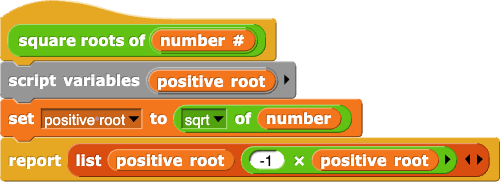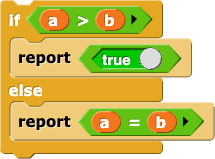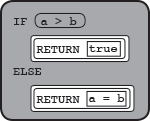a > bis true.
sum block, which combines two numbers using addition: 
sum block, which combines two numbers using addition: 
maximum (reporting the larger of two input numbers) and minimum (reporting the smaller of two input numbers):

The  block takes two inputs: a list and an operation with two inputs, and it reports the result of combining all the elements in the input list using the input operation. For example, the expression below reports: 0 + 1 + 2.
block takes two inputs: a list and an operation with two inputs, and it reports the result of combining all the elements in the input list using the input operation. For example, the expression below reports: 0 + 1 + 2.

You choose the operation, and combine performs that operation by combining all the items in the input list and then reports the result.
Notice that the function used to combine the list items always has two blank input slots. The keep block only needs one blank in its input function, but with combine, two are required.
Combine is a higher-order function; it is a function that takes a function as input. You've seen another higher-order function already: keep (in Unit 2 Lab 3).
Unlike keep, the combine function is only used with a few input functions.
Which functions?
Combine is mostly used with only these functions:






and the  and
and  blocks you've just written yourself.
blocks you've just written yourself.
 would be ambiguous.
would be ambiguous.
combine to build maximum of list and minimum of list.

sum of list block that reports the sum of the items of a list.
average of list block that calculates the average of the items in a list:
average of list
First think: how do you calculate an average? Then think: what blocks could help you do that in Snap!?
Average of list and sum of list are procedures that you'll need repeatedly, so after a while, you just know how to write them, or you'll put them in a library, and you won't have to reinvent them each time. Finding the maximum or minimum value in a list and checking for divisibility are also commonly needed algorithms.
RETURN(like
report). For example, this definitionIn many languages (including Snap!) variables must be declared in some way (in Snap!, you can click the "Make a variable" button or use the script variables block). But the AP's language doesn't include variable declarations, so you won't see them on the exam.

PROCEDURE squareRoots(number)
{
positiveRoot ← sqrt(number)
RETURN([positiveRoot, -1 * positiveRoot])
}
report in Snap!, when a RETURNstatement is executed, the flow of control returns to the place in your code where the procedure was called, and the procedure returns the value of the expression inside the
RETURNcommand or
report block.sqrtisn't built in to the AP's language so it is written in lower case like other programmer-defined procedures.
def squareRoots(number):
positiveRoot = sqrt(number)
report [positiveRoot, -1 * positiveRoot]
script variables block. The first time you set a variable, it is automatically created.)
 would be written as
would be written as IF(a > b)
{
RETURN(true)
}
ELSE
{
RETURN(a = b)
}
a > bis true, the code in first block of statements runs; if it is false, the code in second block of statements runs.
if a > b:
report True
else:
report a == b
When will "Error. Invalid entry." be displayed?
PROCEDURE greaterThanOrEqualTo(a, b)
IF(a > b)
{
RETURN(true)
}
ELSE
{
RETURN(a = b)
}
DISPLAY("Error. Invalid entry.")
}
a > bis true.
RETURNdoes. Like
report in Snap!, RETURNends the procedure. Once it is run, no other code in that procedure is run, and the flow of control returns to the place where the procedure was called.
a > bis false.
RETURNdoes. Like
report in Snap!, RETURNends the procedure. Once it is run, no other code in that procedure is run, and the flow of control returns to the place where the procedure was called.
RETURNdoes. Like
report in Snap!, RETURNends the procedure. Once it is run, no other code in that procedure is run, and the flow of control returns to the place where the procedure was called.
greatest common divisor block. (Use your  block.)
block.)

greatest common divisor
maximum of list as well as divisors and also to build an intersection block that takes two lists as input and reports all of the items that are on both lists.
greatest common divisor